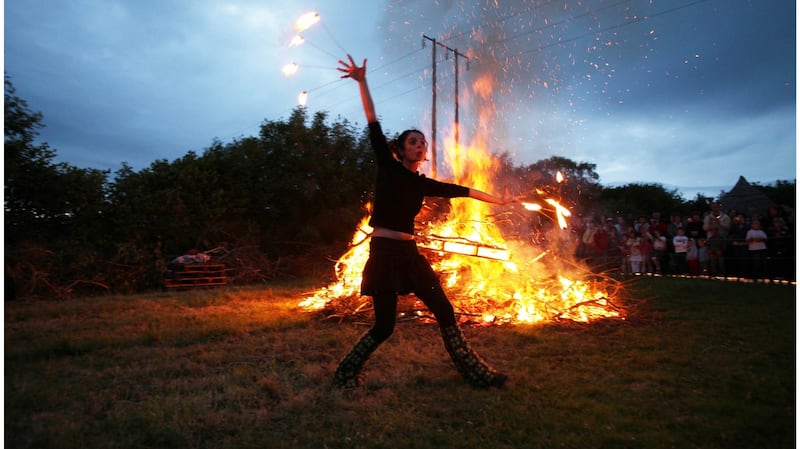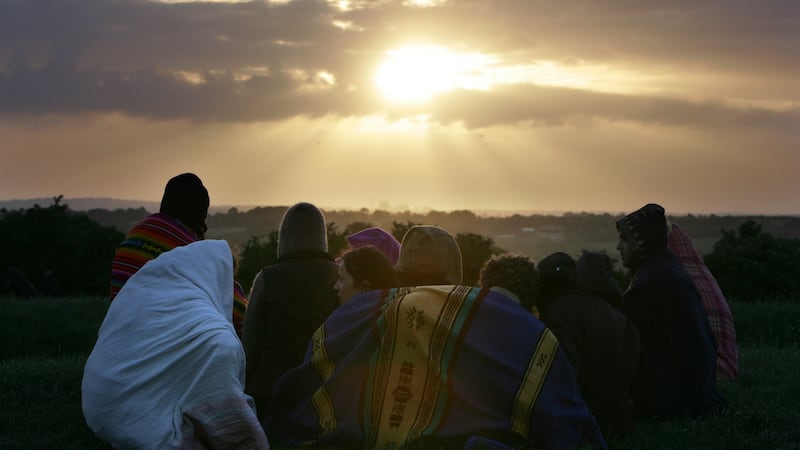One Midsummer’s day in Mayo years ago, I went for an early morning walk by a lake. The sun shone brightly after a recent shower and I noticed a skeach – a solitary whitethorn – standing silently between the path and the lapping waters. A few raindrops glinted on its sharp thorns and the light glittered on the still damp leaves. Gentle wisps of steam were rising in the warmth and by a trick of refracted sunlight, scores of minuscule rainbows shimmered about the branches. It was beautiful, hypnotic and eerie.
Landscapes make their own mythology. The vast plains and tall skies of the American midwest evoked Manitou, the Great Spirit; the blizzards and ravines of the Himalayas conjured the Abominable Snowman or Yeti; and here in Ireland, a single thorn tree can house a host of ‘little people’ – creatures whose diminutive stature is commensurate with the intimate terrain of our small island. Momentarily mesmerised by that tree in Mayo, I almost heard the tapping of miniature hammers and a tinkle of tiny laughter.
‘The little people’ is a patronising phrase evoking images of prankster pixies and right now, on our city streets, leprechaun outfits of green, felt hats and ginger beards are readily available at extortionate prices. The tourists snap them up and the traders make a mint, both cheerfully conniving in the charming but flawed image of a native peasantry simple enough to be spooked by mischievous midgets.

In reality the ancient folklore was darker and the original template of what became the twinkling leprechaun was much more powerful and dangerous. Malevolent ‘Sidhe’ could poison livestock, blight potatoes or abduct babies – but at this time of the year a potent counteractive charm was the magic inherent in the communal fire lit on the summer solstice.
Christianity has been a durable but thin veneer in Ireland: as late as the 19th century, Sir William Wilde, Oscar’s father, recorded the many uncanny benefits accrued by leaping over the Midsummer bonfire. They included ensuring a safe journey; acquiring invulnerability before a dangerous task; undergoing purification before a wedding; and guaranteeing a good husband if you were single, or an easy labour if you were pregnant. The power of the flames was invoked to forestall blight or a bad harvest. Bodily immersion in the smoke was a protection against witchcraft. But the particular attribute of the solstice fire was its ability to dispose of troubles – to actually incinerate them. Especially bothersome weeds were burnt to prevent them recurring and bad luck charms or indeed, any artefacts with supernatural powers, were only safely destroyed by being burnt on the Midsummer fire.
There was an old piseog, or country superstition, which invested supernatural qualities in underwear belonging to a girl reputed to be the daughter of a priest. Whenever she hung her laundered linen out to dry, it gave passing childless women, armed with scissors, the opportunity to cut out a piece and stitch it to the gusset of their own pants as a sure fire charm to aid conception. After the enchanted drawers had done their job they could only be properly disposed of by being ritually flung on the flames at the solstice. In 1940s Limerick, a story was still being told of such instance from a century earlier of one pair of magic knickers resulting in the birth of a dozen children: particularly potent pants.

The communal, Midsummer bonfires were also occasions for fun. They were a focal point for dancing, music and general roistering. Improvised fireworks were common – boys competitively threw burning brands from the fire high in the air and people cheered and went “Ooooh!” as they watched the trail of sparks. In these old Celtic festivals with their heady mix of fierce celebration and vital magic, I sense the lingering presence of a goddess. And sure enough, the solstice was sacred to Aine. Mythological accounts of her origins vary: she was either the wife or daughter of the sea god Manannan MacLir. In her own right she was the summer goddess of sovereignty, wealth and love and was often personified as a red mare.
The sovereignty Aine symbolised was intimate and personal. She espoused self determination and individual power over one’s own destiny. It was Aine you invoked in order to experience true joy in life. The wealth she brought was the largesse of the season: the fat cattle in the rich fields, the ripening corn, the full grown lambs and the rivers full of fish. But it was as goddess of love that I most admire her. Aine’s love was not an ascetic, anodyne, spiritual affair, but a deep, earthy, erotic joy. She had both appetite and aptitude. She is to Tantric sex what white water rafting is to a paddling pool. She delighted in taking mortal men as her lovers and taught them how to properly respect and satisfy a woman. If I had known of her as a hormonally explosive teenager, I would have become her acolyte. I would have built mighty bonfires in her honour and prayed for her to come to me and ravish me in a sacred manner.
There are many legends of the mortal men to whom Aine bore strange, ethereal children, one of whom was known as ‘the Magician’. This may have been the origin of the character Welsh Celts knew as Merlin and earlier minds must have thought wizardry was afoot on Midsummer’s day. At noon on the solstice the sun seems to hang for a timeless moment before beginning its long descent into winter: in fact the word derives from the Latin ‘sol’ for sun and ‘sistere’ – to stand still. But though I know the days inevitably shorten from here on, I still feel the summer’s height is only beginning.
The other morning I opened our bedroom shutters and was dazzled by a Mediterranean blaze. The cloudless sky was azure and the vegetable garden was green upon green with peas, beans, potatoes, courgettes, carrots, lettuce and leeks. I made breakfast for the boys then my wife and I took mugs of tea outside. We sat and looked across the valley to the blue hills on the horizon. Juicy red blobs of Fuchsia drooped from the hedgerows and the burnt orange sprays of Montbretia were starting to emerge. In the field behind, Farmer Friend was putting a couple of late calves out to grass. It's hard not to believe that Aine the goddess has blessed us.
In Sight of Yellow Mountain: A Year in the Irish Countryside by Philip Judge is published by Gill Books











